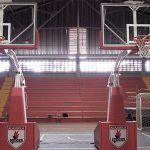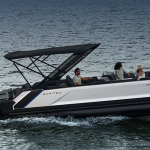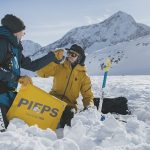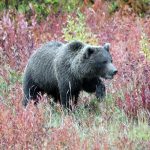Overall sales for the entire winter sport market, including specialty and chain stores, were up 9% in dollars to $348.8 million for the August through October period of 2005, compared to $319.6 million reported last year, according to the SnowSports Industries America Retail Audit. Unit sales were up 10%. Sales at chain stores were up 6% compared to last season. In dollars, that translates to $70.3 million in sales compared to $66.1 million for the same period last season. Unit sales were up from last season 4%.
“Early snow and rising heating bills resulted in increased apparel sales at chain stores for August through October. Price-friendly softshell parkas, vests, fleece tops and fleece bottoms highlighted the consumer trends for the three month period,” said Christine Martinez, market research manager for SIA, the not-for-profit industry trade group that represents manufacturers and distributors of snow sports products. The SIA Retail Audit tracks and reports sales in all snow sports product categories. This is the first report of six that look at sales through March 31, 2006, the end of the winter season.
Overall equipment sales (alpine, snowboard, Nordic, Telemark and Randonee/AT) were down less than 1% in dollars as compared to last season with season-to-date sales totaling $15.7 million. Alpine equipment sales (including skis, systems, boots, bindings and poles) were down 3% in dollars as compared to last season ending October 2005 with $7.8 million in sales. Retail selling prices dipped 6%.
Integrated ski system sales continue to grow in the chain stores totaling $1.6 million through the end of October, an increase of 14% in dollars when comparing this August to October period to the same period a year ago. Out of all integrated ski systems sold so far this season, 59% of the units were midfats and 28% were carvers.
Add alpine skis to integrated ski systems and total ski dollar sales jumped 10% this season. Alpine skis, excluding integrated systems, also increased, up 8% in dollars, with a total of $2.6 million in sales. Fat skis (up 88%), twintip skis (up 77%) and carve skis (up 147%) each saw dollar increases as compared to the same period last season.
From August October of this season, alpine boots decreased 15% in dollars with a total of $2.6 million in sales. Recreation boots were the only boots to show sales growth over last season up 13% with sales at $349,000. Carryover boot sales dropped 25% in dollars. In the August – October period, carryover boots accounted for 16% of all boot units sold, down from 20% in 2004.
Add stand-alone alpine bindings to those attached to integrated systems and total binding sales were flat, down 0.04% in dollars. Stand-alone binding sales fell 19% in dollars over last season, with season-to-date sales reaching $795,000. All binding categories showed dollar decreases this season over last — DIN 1-7 (down 38%), DIN 8-11 (down 17%), DIN 12-14 (down 12%), juniors (down 35%) and carryover (down 48%).
Alpine pole sales jumped 29% over the same period last season, reaching $308,000 in season-to-date sales. Adult pole (up 24%), junior pole (up 49%) and carryover pole (up 63%) sales contributed to the category performance.
Nordic ski equipment sales (including skis, boots, bindings and poles) dropped considerably this season over last, down 65% in dollars and totaling $185,000 in sales. Nordic skis, (down 65%), boots (down 72%) bindings (down 70%) and poles (down 51%) all experienced losses in dollar sales over last season.
Telemark ski equipment (including skis, boots and bindings) dollars were flat, up 0.2%, ending October 2005 with $165,000 in sales. Telemark skis managed a 40% boost in dollar sales this season over last but sold fewer than 250 units.
By the end of October 2005, snowboard equipment sales were up 8% in dollars as compared to last season with total sales reaching $7.4 million. Snowboard sales gained 18% over last season. All mountain boards grew 20% in dollars while freestyle boards jumped 28% in dollars. Freeride boards, the largest category with 41% of all snowboard units sold, managed a 21% gain in dollars this season over last.
Sales of snowboard boots fell 7% with sales reaching $2.2 million through the end of October. Snowboard bindings, on the other hand, managed a 12% dollar increase and sales of $1.6 million.
Retailers did not have a lot of snowboard equipment left over to sell this season as carryover snowboard, boot and binding sales each declined 6%, 63% and 54%, respectively, in dollars.
Chain store apparel sales started off the season on a positive note with a 15% dollar increase and season-to-date sales reaching $33.4 million. Apparel top sales spiked 21% in dollars this season over last.
Insulated parkas (up 14%), softshell parkas (up 254%), shell parkas (up 3%), fleece – includes vests (up 36%) and vests – no fleece (up 92%) all experienced dollar increases as compared to last season. Season-to-date, softshell parkas accounted for 8% of all alpine apparel tops sold, up from just 2% last year at this time. Apparel suits and bibs are also drawing increased interest with dollar gains of 25% and 5%, respectively.
As in the specialty stores, junior apparel is showing improvement in chain stores this season over last. Sales of junior insulated parkas, junior softshell parkas, junior suits and junior bottoms (as well as junior snowboard tops and bottoms mentioned below) all experienced dollar increases as compared to the August through October period last season.
Snowboard apparel, most specifically for adults, did not live up to last seasons sales. Snowboard tops declined 2% in dollars with sales totaling $2.2 million. Junior tops drove category sales with a 19% dollar increase this season over last. Snowboard bottoms also declined, down 28% as compared to last August through October. Junior bottoms also saved this category with a gain of 12% in dollars.
The entire accessories category was flat this season over last. Apparel accessories brought in $11.5 million in sales thus far this season, a 0.1% increase over last season. Winter boots (down 18%), gloves (down 27%), mitts (down 27%), base layer (down 30%) and turtlenecks (down 50%), specifically, drove the category dollar decline. Equipment accessories brought in $9.7 million in sales thus far this season, a 0.7% decrease over last season. Snowshoes, technical day packs and wax managed to have dollar boosts, up 117%, 23% and 3%, respectively.















